Art
Bouthillier
And
the Brutal albeit Beatific Truth about Freelancing Magazine Cartoons
From the deck at the rear of Art Bouthillier’s place near Langley on Whidbey Island, we look out across a tranquil stretch of Puget Sound called Saratoga Passage, which separates Whidbey Island from the mainland and Everett, Washington, the nearest sizable city, just north of Seattle. A grassy sward slopes down toward the water’s edge, which, due to the increasingly sharp drop-off, is out-of-sight below us. An occasional boat appears in the distance, and then, soundlessly at this remove, disappears. The only sound we hear as we talk is the plaintive solitary ding of a far-off bell buoy.
 |
 |
What Bouthillier enjoys most about his life as a freelance magazine cartoonist is the freedom. “I don’t have a nine-to-five job,” he said. “I don’t have to be anywhere.”
By the same token, he can be anywhere he likes to be. And he likes where he is now. “I like Washington,” he said, “because of the scenery and the beaches and things like that. And I can come and go when I want. That’s nice. It would be hard for me to get a regular job. Because it would be hard to have to be some place every day to put in a specific amount of time.”
When I met him in July 1998, Bouthillier was among the last of a dying breed—a freelance cartoonist making a living, however hand-to-mouth, solely by selling gag cartoons to magazines. The number of magazines that publish cartoons was steadily diminishing in those days; it had been since the 1960s, and it still is. And the payment was likewise increasingly minuscule; still is. In 2003, when I finally got around to getting my interview with him published in Cartoonist PROfiles, Art was still at it: with a dedication so fierce it was heroic, he pursued the profession he loved. And he’s still at it today, 2009: his passion and perseverance over a career of more than 20 years make him an exemplar for the profession—a man whose story must be an inspiration to us all, particularly in these tenebrous times with cartooning increasingly endangered in every print medium except comic books. Here’s the rest of the article as published in PROfiles:
Bouthillier’s island retreat is a tiny clapboard cabin that encloses a livingroom bracketed by kitchen and bedroom on either side, and an enclosed back porch that serves him as office, at one end, and, at the other, studio. Its windows overlook the grassy sward, Saratoga Passage, and the distant bell buoy. It is, in my mind, a perfect hideaway, a peaceful pause in the otherwise hectic progress of the madding crowd, a workplace so placid that it cannot help but foster the creative impulse.
But freelancing cartoons to magazines has its downside. It may be the most precarious of cartooning careers. Bouthillier has been selling regularly to such major markets as National Enquirer, Woman’s World, Phi Delta Kappan, Better Homes and Gardens, and Hustler and other men’s magazines for over 18 years. But on the day I drove up to his idyllic redoubt that summer of 1998, he was, he said, severely “bummed” by a check he’d just received from Hustler Humor.
“I’ve been selling a lot of cartoons to Hustler—and to Hustler Humor, in particular,” Bouthillier said. “I did a one-page strip a year ago, and they paid $75. They asked me to do some more strips for them, so I did a bunch of full-page strips, and they accepted a lot of them, but then they changed their page rate! I can’t believe they did this. I had five pages in the last issue, the July issue of Hustler Humor, and I just got a check from them. It worked out to $15 apiece! Their letter said the pay scale on full pages varies from $15 to $75. My previous check from them was $75 a page. And now all of a sudden, I’m getting the low end instead of the high end that started me off. I don’t want to sound like a victim, and I’m not. But whatever they say, I have to take.
“But I don’t plan on sending them any more strips,” he continued. “These strips take about 2 ½ hours to do. You don’t mind doing them if you’ll be paid well. And I thought $75 was low. I could do a single-panel cartoon for one of the other men’s magazines and get $100—for 20 minutes’ worth of work. I did the strips because I liked doing them, and $75 isn’t too bad. If I can do one in 2 ½ hours, $75 isn’t bad pay. But $15? Forget it. I’m not sure if I’ll write them a letter about that or not. I don’t think it’s very fair. I’m a professional. I’ve been doing this for fourteen years. A lot of people start out in Hustler Humor, and they say, ‘Well, it’s good exposure.’ I don’t need the exposure. And not that many people read Hustler Humor anyway. If I get into Better Homes and Gardens, eight million people are going to see that. Eight million are going to see my work in the National Enquirer. So if you talk about exposure, those are the ones to be in, and I’m in them.
“You don’t get into cartooning for the money,” he went on; “you get into it because you love it. But I have to make a living here, and money is the bottom line. That’s how I pay my bills. I really feel ripped off, and there’s nothing I can do about it. I can gripe and moan, but if they say, ‘Well, forget it then’—then I’m out. It’s a real precarious job. You never know when you’re going to get paid. You never know who’s going to fold and affect your paycheck. It’s hard to make long-term commitments like vacation and things like that because you don’t know if the money is going to be there when the time comes. You just don’t.
“That’s the ‘con’ of the whole business,” he said. “The ‘pro’ is that I’m doing what I enjoy doing, which is drawing cartoons, and I get paid for doing it. Sometimes it’s not a lot; sometimes, it is. There are about five or six magazines out there that treat their cartoonists well. And I really like working for them. The Score Group—an excellent company to work for. Run by John Fox. Remember John Fox? He was the editor of Gent, and he left Gent and started his own company called the Score Group, and they publish about five magazines, and they’re so good to me. Their pay isn’t the greatest, but they buy a lot. And they pay a hundred bucks for color. They always send nice letters. They’re a great company to work for.
“The National Enquirer is great to work for. Better Homes and Gardens are great people.
The people at Dog Fancy are big fans of mine. Woman’s World is another magazine that’s good to work for. I like the ladies there a lot; they’re really nice. I talk to them on the phone. And they’re good customers. They have buying periods. They’ll buy three or four from me, and then—I usually get a lump sum check all at once—$375 or $500 or something like that. That’s nice.
“There are about three or four others,” he went on. “I really enjoy doing work for them. I put a lot of energy into focusing into their market to see what they want. So that’s a ‘pro,’ when they send back a little feedback, or they give you a little pay raise. That tells you that they like you. And they buy on a regular basis.
“Another advantage to being a freelancer is the freedom that I have to be able to live where I want. This is a pretty nice spot to live. Got a forest over there to run the dog in, and a beach to go to if I want it. When the sun is shining and it’s a really nice day, I’m out of here! And I couldn’t do that in another job. So that’s definitely an advantage!”
But Bouthillier doesn’t play hooky often. He grinds away at his job with great persistence and determination, following a rigorous regimen.
“The ritual begins with having a clear schedule,” he said. “That’s the main thing. I have to have a day without any commitments. And I can usually do that four days a week. I can arrange that. Social schedule and all that—they pretty much leave me alone for four days out of the week. I like to have the entire day open—and the night, if possible. That way, I can get into the flow better. I have nothing else on my mind then but cartoons. And then I start to focus on getting ideas for the cartoons.”
First, he puts himself in a frame of mind for a particular market.
“You can’t make any money doing the cartoons you think are funny as opposed to what the market is going to buy,” he said. “It seems like all I think about is the bottom line, but you have to have that in mind when you’re working. Let’s say I’ll focus on the Enquirer. The Enquirer is the main one that I think about, but those cartoons will sell at Woman’s World and Better Homes and Gardens. So there are about four or five really good paying markets in that category, and they all like ‘general’ cartoons. So I might start by saying, ‘What’s on my mind?’ Okay, grocery shopping. Maybe I’ve gone shopping the day before. And then I’ll break it down. What’ll it be? Will it be buying things? Do I think about the items in the store? Or will it be how the shoppers are acting in the store?
“I remember one day I went up to Safeway and there were people being idiots with shopping carts. It looked like there should be a traffic cop in the store. So the next day when I was thinking of cartoons, I decided to do people with shopping carts. And I did quite a few. I did one of a guy who knocked over a display—a display of a stack of cans. And the clerk says, ‘This isn’t a problem; the problem is that you probably drive a car.’ And that was in my mind when someone had whacked right into my cart. And that one sold. Another one—a lady speeding through the aisles, running with her cart, and a police officer is chasing after her with a shopping cart that has a flashing light on it. That sold. And a few others in that batch sold.”
Diversity is the key to success in freelancing, Bouthillier said. The cartoonist must be able to appeal to a variety of markets—adult humor, family humor, pets, children, sports, and Christian humor.
“One of the things about the girlie market is that I can get away with doing tasteless jokes, jokes that don’t need to be pornographic. Sometimes those jokes can transfer over to the Enquirer. I revamp the gag and change the drawing a little bit, but basically, it’s the same.
“What I have to do,” he continued, “is to keep my focus very very narrow for me to concentrate on a brand new idea. Let’s say I do that with kids. If I do it with kids, where are they going to be? In the playground? Or in the house? Or are they going to be in school? And once I get one good idea, I can usually go off that and get some more on the same line. Very rarely do I bounce around with different things. Very rarely would I do shopping cart cartoons and kids and girlie cartoons all at the same sitting. It’s hard for me to stay focused on that. And then sometimes if I want to do really off-the-wall cartoons—usually some without a caption—that’s the way I’ll start off, with that idea in mind. No captions.
“Another time, I’ll start putting together things in my head that don’t match. Nuns and elephants. Sailboats and houses. One time it was pool tables and roofs. This one was fairly recent, and I sold this one, too. I drew the top of a house with a guy playing pool on a pool table on the roof, and the caption was, ‘My wife and I compromised.’ Refrigerator on a roof would be totally out-of-place. Things like that, things that are totally out-of-place. The refrigerator on the roof is one I sold to the Enquirer. I drew a guy climbing up a ladder to get to the refrigerator, and his wife is outside talking to a neighbor, and she says, ‘Harvey has lost so much weight since we moved the refrigerator.’ That’s how I do that.
“Television gives me a lot of ideas. Jerry Springer and the news. Things like that give me a lot of ideas. I start out with a blank sheet of paper. Sometimes I’ll think of gags as fast as I can write them down, but most of the time, I just sit down and stare at a blank sheet of paper.”
Bouthillier doesn’t carry a notepad around with him, but he carries a convenient supply of pens, and if he has an idea, he grabs a pen and writes on whatever is handy—napkin, back of a check, an envelope. Anything.
Generating ideas for cartoons is a matter of training.
Says Bouthillier: “It’s like boxing. Somebody asked a boxer during an interview how he deals with the pain while he’s boxing, and he said, ‘You train yourself out of pain.’ I did martial arts for quite a few years. That was the same thing. The movement in martial arts is so foreign to you when you start, but after a few years of training, it becomes natural, and it becomes instinct. And that’s the same way with doing cartoons. You sit down, and you just do it. It’s because you’ve trained yourself over a period of time to do it. There are times when I come up blank; or I do some cartoons that I don’t think are very funny and I won’t send out, but you train your brain. You just know how to do it. I’ve been doing it for years. I get the ideas from everything and I get them from nothing.”
Bouthillier keeps a notebook of ideas.
“This is an old cliche,” he said, pointing to a note that said: “‘Sure I get plenty of exercise: I jog to the donut shop every morning.’ That one’s been used a million times, so I won’t even do it.”
I volunteered that sometimes you can take a cliche and turn it on its head somehow.
“Sometimes,” he agreed. “In fact, I have a theory that there aren’t any new ideas. Just old ones modernized. I can take some old idea from thirty or forty years ago and turn it around. You can turn someone’s amazement at a telephone into amazement at a computer.
“Here’s a fat guy reading a ‘Diets Don’t Work’ book,” he continued, returning to the notations in his notebook. “Remember that theory? So I drew a really big fat guy reading this book, and he’s saying, ‘Right on, right on!’ Here’s when I was working on dog cartoons, and I wrote down all the things that dogs do—just a list. And I did cartoons on slobber and going for a walk and all the rest.”
Bouthillier’s work days begin early.
“My schedule is really bad,” he said. “It burns me out. That’s why I work only four days a week. The best time for me to draw is early in the morning, like from seven o’clock until eleven or noon. And then at night from about 6 o’clock until midnight. In the afternoon, I’m shot. No ideas. I’ve never been productive in the afternoon. Never. Even if I have gags that I wrote the day before, there’s just no way that I can do them. Low energy is tough on creativity. But early in the morning, it’s there; and late at night, it’s there. So that’s the schedule I keep four days a week. It’s not really good when you have a girlfriend or social engagements. And sometimes I get burned out because I don’t quit drawing until eleven or twelve at night and then stay up until two o’clock, and then get up at seven the next morning. A lot of the time, I’m pretty burned out by the end of the week. It’s not like it’s a real easy job where you don’t get tired and you have plenty of time to go play golf. Some guys do. But I work pretty hard at it; I’m pretty hard on myself when it comes to doing a quota of cartoons a week. I try to do at least 32 cartoons a week. If not more. And I’m pretty hard on myself if I come up short of that.”
Since we talked in 1998, Bouthillier had married and become a father. And that changed his schedule but did not diminish his dedication. When I talked with him in 2002 to update the interview, he told me he now spends the days taking care of his 15-month-old daughter Sierra while his wife Jennee is at work; then, after the baby is put to bed in the evening, the cartoonist sits down at his drawing board at the “studio” end of his back porch and works through the night until 5 a.m. He logs a couple of additional hours of sleep during the day by napping when Sierra naps. With this schedule, he continues to maintain the four-workdays-a-week routine.
The fifth day is a workday, too, but he devotes it to the other aspects of the business—keeping cartoons in circulation and recording their whereabouts. He has 30-40 batches of cartoons out much of the time, and as envelopes of cartoons return from magazines, he piles them on his desk in the “office” end of his porch all week until Friday. On Friday, he opens the envelopes, records sales, packages the remaining cartoons to be sent out again, and notes their destinations (date sent and date returned) in a steno pad he keeps for that purpose. Every cartoon is stamped with his name and mailing address, and each one bears a distinctive 5-digit number so he can keep track of where it has been submitted. He maintains a separate list of the cartoons by number with short descriptions of each. He thought, once, of putting it all on computer, but then one day his computer crashed, and he decided he wouldn’t risk entrusting his livelihood to an appliance.
Speaking before the Cartoonists Northwest meeting in November 2001, Bouthillier said he prefers using clasp-type envelopes because he doesn’t like licking envelope flaps. Licking slows him down, and speed is important when processing dozens of batches. When the Postal Service introduced pressure-sensitive stamps that don’t need to be licked, Bouthillier said it threw him off his rhythm for about a week, but he soon came to love the new breed.
“I spent years lickin’,” he said, “and now I’m stickin’.”
Bouthillier’s weekly quota is four batches of cartoons.
“I send small batches,” he explained. “I think that when an editor gets a stack that’s an inch high, he’s probably going to go through them pretty fast—if at all. So I try to send no more than 12 in a batch. And that way, seeing a thin batch, the editor knows he can look through it pretty quick. He’s not overwhelmed. So I send batches of 8-12 cartoons on 8 ½ x 11-inch paper.”
He often puts in a short note when he knows the editor, but he doesn’t ask a lot of questions.
“Most of the time, the editors don’t have the time to answer back anyhow,” he said. “At this point, I’ve been working for some of these magazines for fourteen years. Dugent was about my third sale. I still sell to my first outlet. You establish a rapport over a period of time, so I feel pretty free to phone them if I have a question. And the funny thing is that a lot of magazines have gone through three or four editors since I first sold to them, and so I’ve been working for the magazine longer than they have.”
He sends photocopies of his cartoons, not the original drawings. This practice is his insurance against disaster. Envelopes can get lost in the mail or be torn up by the machines that process them. And some magazines have a bad habit of stamping the date they receive submissions on the front of the cartoons; those can’t be sent out again. Repeated submissions simply wear out the cartoons, too.
“After a cartoon has been to eighteen magazines, it’s pretty messed-up looking,” he said. “So I make copies and send out copies, and when the copies start to look at little ragged, I make a fresh batch of copies. And that makes them look clean and new; they don’t look like they’ve been around the block a million time. Most magazines use the copies, and I get to keep the original. But if a magazine requests the original, I’ll give it to them.”
Following the traditional practice with freelance magazine cartoonists, Bouthillier sends each new batch to the highest paying market in that category first: for “generals” (cartoons on everyday living, family, etc.), he starts with the National Enquirer, then works down the pay scale, going to other magazines that buy generals (Woman’s World, then Better Homes and Gardens and so on). He submits the remaining unsold cartoons in each batch to successively lower-paying magazines until a batch has been just about anywhere that might buy from it. But he sometimes short-circuits the drill.
“Sometimes I’ll send Woman’s World a batch without sending it to the Enquirer first if, say, sales have been slow at the Enquirer. They might tell me they’re stocked up for awhile. Then I won’t waste my time with it. I’ll just send them to Woman’s World first. Or to Better Homes and Gardens. The turn-around time is good at both places.
“Better Homes and Gardens uses only two cartoons in an issue; that’s only twenty-four in a year. And that’s up. They used to publish only one an issue. But I sell maybe three or four a year there. Three hundred bucks apiece. They pay well. It’s worth it. Some batches I do better than others. In one batch that I sent out, I sold every single cartoon—to different magazines. That was a great batch. I must’ve been right-on that day. Then there are other batches where I don’t sell anything.”
Most magazines don’t pay until the cartoons have been published, which puts the freelance cartoonist’s income on a hand-to-mouth basis.
“I have to generate so many cartoons a week in order to pay my bills,” Bouthillier said, “and those cartoons just predict payment. I might be waiting for the money four months down the line.”
Some magazines will take cartoons month after month without paying, and then Bouthillier will get a lump-sum payment of several hundred dollars. Nice when it happens, but it might be nicer if the checks were smaller and came at more predictable intervals.
Exacerbating an already chancy financial enterprise, a magazine that bought cartoons regularly for years might decide, without warning, to stop using cartoons. Bouthillier has been confronted with this development several times. One year, his income might be $30,000; the next, due to folding magazines and the like, it might drop to $15,000.
“We’re definitely vulnerable to corporate decisions,” he said. “When they decide to run more ads and less cartoons, I’m the victim of that. And I don’t believe they think cutting a couple cartoons here and there is a big deal for the cartoonist, but it is when you’re generating $800-900 a month off regular customers, and then everything else is hit and miss. Sell here and there. One year, a lot of magazines cut back. The National Enquirer was one. And Dugent, which published several magazines and bought three, sometimes as many as six, cartoons a month—Dugent stopped publishing one of the magazines, and another adult market stopped using altogether. And that really hurt when all those came down at once. It really hurt. I almost gave it up then, gave up cartooning. I came really close to getting a job.”
Then he discovered new markets and, revived, kept on. But the collapse of several markets at once prompted him to seek a steadier income through syndication to newspapers. When I visited him, he was trying to sell a panel cartoon called Henry McHenry about an ordinary citizen and his wife and his dog.
“As a goal, I’d rather do a syndicated panel than a strip,” he told me. “I like doing strips without any words. I think I could do a Sunday page that way very easily. But I enjoy doing a panel. The main reason is that it gives you a brief glimpse into someone’s life. I like that. I like the humor of that: it doesn’t take three panels to get to the joke. It’s like you’re walking by and you just catch a snippet of somebody’s conversation or situation.”
I remarked that at the New Yorker, they used to refer to captions of the cartoons as “overheard conversations.”
“Yes,” he said. “That’s really what it is. I’ve got so many cartoon ideas that way.”
Breaking into syndication, or any other cartooning enterprise, from magazine cartooning is difficult because the time needed to prepare the new endeavor takes time away from earning bread and butter.
Said Bouthillier: “I spend four days a week drawing magazine cartoons—because I have to stay ahead and I have to keep hitting all the magazines, I try to hit them all at least once a week—so it’s really hard to venture out into other things. If I spend a month working on a strip alone, I may not have any income a few months down the road. Henry McHenry took me a month-and-a-half to put together. I had the character down over a period a time from using him in magazine cartoons, so I decided to put it together as a proposal to a syndicate. But it took a month-and-a-half to redraw older cartoons and to do some brand new gags and put it all together. It’s time-consuming, and you put a lot of energy into it. It’s hard when you have something rejected that you’ve put a month-and-a-half into. That’s a lot of work.”
Work and pleasure. Bouthillier can’t remember when he didn’t draw. He’s had a drawing table since he was fourteen. He drew cartoons for his middle school newspaper and for his high school newspaper in San Carlos, California. After high school, he held several nondescript jobs before finally deciding to pursue his first passion, cartooning. He moved to Seattle in 1980 and lived with his brother for a year or so, then went back to California for a couple years.
He started doing cartoons at night and submitting them to magazines by mail while working days at the coroner’s office in San Mateo County. Then he met several cartoonists by taking a course in cartooning—Glen Bernhardt and Wiley Miller and a gag-writer named Ed Mitchell (founder of a cartoonists club in northern California). Soon after, he decided to go into cartooning full-time.
“I was a little tired of working for a living,” Bouthillier said. “It was either go to college and get a degree or learn a trade, or try to make it in cartooning. And one of the things that came to mind was that I didn’t want to wake up twenty or thirty years later, thinking that’s what I should have done.”
He made his first sale in 1984 and started doing it full-time the next year, when he returned to Washington. He’s been making a living as a magazine cartoonist ever since.
“It’s a living,” he said, “—a small living. It’s a very small living. If you can live off $20,000 a year and call that a living, then it’s a living.”
He augments his magazine income slightly by doing a weekly editorial cartoon for the local newspaper, the South Whidbey Record. The money isn’t much but he can overdose on local notoriety.
“The police chief stopped me this morning,” Bouthillier said, “and he asked me why I haven’t ranked on the police department lately. He said, ‘We must be doing a good job because you haven’t ranked on us lately.’ I’ve done three or four on the police department. I send them the original. And he loved them.
“Funny thing, though. People connect me to the editorial cartoons but not to the magazine cartoons. I’ve seen my magazine cartoons in stores around here, clipped out of the magazines and posted, and people didn’t know it was me. The other day, the guy at the grocery store says, ‘Oh, you’ve got to see this cartoon I clipped out. It’s great.’ So I looked, and it was one of mine. So I said, ‘Yes, it is great: I’m the one who drew that.’”
[Update: after almost 20 years with the Record, Bouthillier moved to the Whidbey Examiner in 2007.]
For aspiring magazine cartoonists, Bouthillier’s advice is to ask a publication for guidelines when submitting for the first time. And he doesn't send a cover letter unless it is the first time he is sending something to a magazine. “A fancy cover letter ain't gonna make the sale,” he said. The cartoons must stand on their own. He suggests that an aspiring cartoonist cut out some favorite magazine cartoons, then copy his (or hers) to the same size and compare them.
“Ask yourself if your artwork stands up when it is placed next to the professional cartoon. If it does, then go ahead and pursue the markets.”
But remember, as he always says: “You don't get into cartooning for the money; you get into because you love it.”
That’s
what Bouthillier did. And he still does.
*****
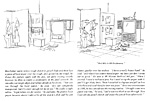 |
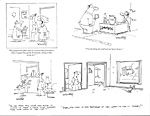 |
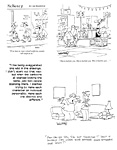 |
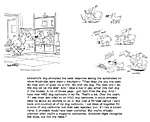 |
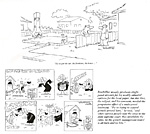 |
The foregoing article appeared in Cartoonist PROfiles, No. 137, March 2003. Some of the information herein was poached from an article by Liz deDesrouchers in Penstuff, the newsletter of Cartoonists Northwest, which, in 1997, conferred upon Bouthillier its annual Toonie Award.
